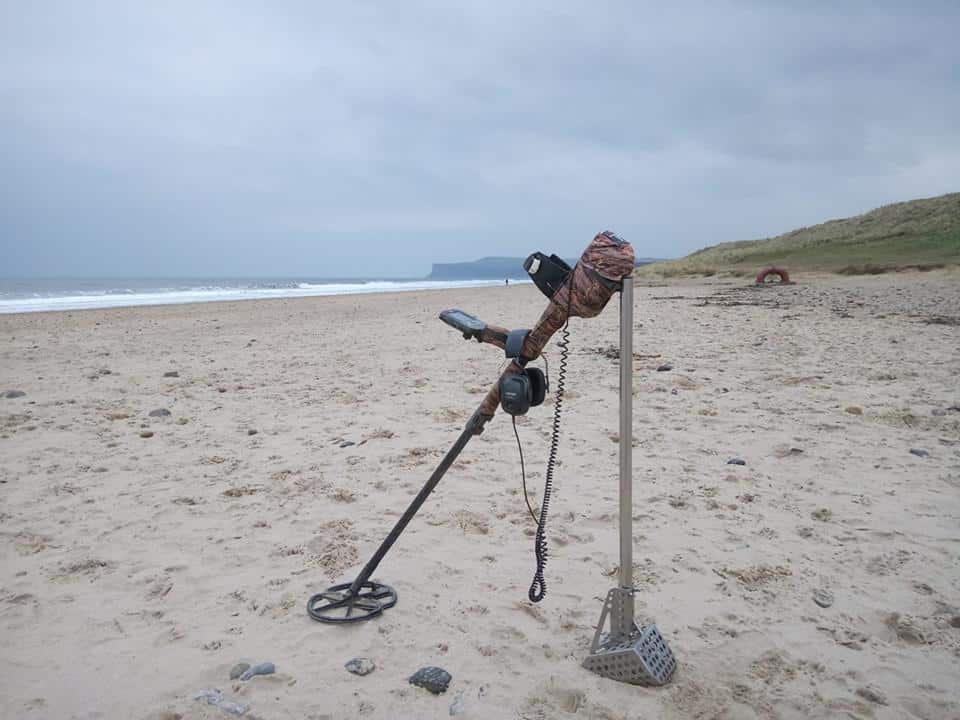
Metal detecting is a fun activity for many people around the world, who love to go on treasure hunting adventures with their detectors.
A metal detector helps you detect the presence of any metal in the area you are hunting. Some detectors even help you find metal inclusions that are hidden within objects as well, along with metal objects that are buried underground.
However, this machine works on electromagnetism and this is why it is not always able to detect some metals easily. This includes stainless steel among others.
So, what can metal detectors NOT detect? Any element that has little to non-electrical conductivity capabilities won’t be seen by most metal detectors. This also applies for elements that don’t have magnetic capabilities (called paramagnetic). In addition, sometimes even if the metal has conductivity but it has an extra mall size, it won’t be detected.
In this Post, I will give many details that you should definitely know about. So, you will be able to understand the scope of elements that your machine can actually cover and the elements that it just can’t!
Metal Detectors cannot detect these Elements
These machines function on electromagnetism. That is they give out time-varying electromagnetic fields and then it listens for the waves coming back from items that are conductive.
One of the most difficult metal to locate with a metal detector is stainless steel because steel has poor electrical conductivity and also has low magnetic permeability. This means that steel does not produce a strong enough signal for a metal detector to pick up and identify.
For most machines to function, they must be able to detect the magnetic field of a metal object. For this to happen, the object also needs to be fairly close to the surface of the ground, preferably within a foot.
If the object is within a foot or two of the ground, then even inexpensive devices can pick them up. When you opt for buying a more expensive and more advanced detector, these can pick up things that are buried much deeper.
Other items that cannot be detected with a metal detector include:
Metal Detectors cannot detect Gemstones directly
Precious and semi-precious stones including diamonds, cannot be detected by your machine unless they are set in a metal fitting, for example in a jewelry fitting.
As these are non-metal items, a metal detector is unable to detect them directly. In some cases, the same indicator for minerals for gold also turns out to be the indicators for diamonds.
The most common of these being glassy green olivine, chromium garnets, magnetite, and black picroilmenite. Magnetite and garnet are both minerals that are pretty good indicators for gold. In many cases, if you strike upon gold, it is quite possible that there is a diamond rock nearby as well. Sometimes, the pure crystals of garnet also turn out to be very valuable.
If you are specifically hunting for raw diamonds and gold, then using a gold metal detector like the Garrett AT Gold (Check it Here at Amazon) that has been specifically built for this purpose, is your best bet.
Many of the gold-hunting metal detectors come with a higher operating frequency that increases the sensitivity of the device. These frequencies start from 20 kHz and could even reach 70 kHz or even higher …
Ultimately, though, the chances of finding gemstones that are attached to a piece of jewelry are much higher than finding them in their natural state in the ground. There are thousands of diamond rings and other jewelry that get lost every year.
Beaches, outdoor concert areas, and golf courses are known to be the ideal locations to search for lost jewelry that may contain gemstones.
I’ve written a complete guide on how to detect diamond using your detector! You will learn much more helpful info there …
Your Machine won’t find Metals Under these Conditions
Apart from not being able to detect certain types of items, metal detectors also cannot detect metals under certain conditions.
The biggest challenge that hobbyists face is that even a very low-frequency metal detector can pick up strong signals from the many ferromagnetic substances present in the sand.
Most sands and soils have a certain amount of iron present and due to this, they end up having conductive properties. Sometimes the presence of salts that are dissolved in groundwater can also lend the sand or soil some conductive properties.
You device can be detecting this signal which is from the ground itself. This makes you waste time digging through the place.
Detecting in a place that is full of junk metal is also unlikely going to throw up anything of value. Your metal detector may also end up signaling continuously with the presence of so much conductive material in the area.
Weather conditions also have a role to play in determining the efficiency of a detecting machine. For example, if you are hunting on grounds that are covered with a thick layer of snow, it will make it more difficult for you to detect a signal from any item that is buried under the snow, and then under the ground as well.
Keep in mind that to deal with such conditions you will need to use one of these detection machines!
Not All Detectors can detect gold nuggets
Most of us dream of hitting upon a stash of gold while out detecting. However, the fact is that not all metal detectors are capable of detecting gold.
With the right equipment though, you can truly turn your gold detecting plans into reality. A lot of careful consideration needs to go into selecting the correct equipment for gold hunting.
For detecting gold nuggets or gold flakes, what you need to be looking for is a Deep Seeking or a Two Box metal detector. Some examples of these include:
- Detech SSP 5100 Deep Seeking System – this machine comes with the unique Discriminating Pulse Induction technology which helps you locate not just gold, but also silver, platinum, and other precious treasures located at extreme depths even. It can easily eliminate the mineral effects in the ground to avoid any confusing signaling.
- Garrett ATX PI (Check it Here at Amazon!) – it helps you to easily detect gold and other treasures at twice the depth of the conventional detectors. It also has one of the most accurate pinpointing and the best small object detection amongst other detectors.
- Fisher Gemini-3 (Check it Here at Amazon!) – this is a reputed metal detector that is designed to search for deeply buried objects. It can even detect objects that are as deep as 20 feet even.
You can learn more by checking these differences between a metal detector and gold detector!
Not All Detectors can detect in mineralized soil
Ground mineralization is a reference to the amount of magnetism present in the soil due to the particles which have metal characteristics and thus are able to produce a magnetic response.
This is picked up by the metal detector! Making you believe that there is something worth searching for below the ground.
Many devices are equipped with automatic or manual ground balance. This allows it to pick up the ground mineralization and thus calibrate itself to ignore it.
On the other hand, pulse induction (PI) technology is better when it comes to coping with ground mineralization as it completely ignores the ground mineralization.
The Minelab GPX 5000 Metal Detector and the Garrett AT Gold Metal Detector are two of the best detectors you should consider when detecting in mineralized grounds.
The Minelab GPX 5000 Metal Detector is believed to be one of the most advanced ones for gold and it is specially designed to hunt for gold nuggets, that too in highly mineralized soil, also making it one of the most expensive metal detectors in the world.
This is generally only selected by the most serious metal detectorists and it can easily reach a depth of 1.5 meters.
The Garrett AT Gold, on the other hand, is the ideal all-terrain metal detector, especially when it comes to detecting in mineralized ground. Deep detecting and increased sensitivity are some of the top features of this device.
Keep in mind that for mineralized Soil, you certainly need to use one of these detection machines!
Not All Detecting Machines can Detect under Water
Your usual metal detector, if not fully water-proof, is likely to stop functioning underwater. Indeed, it could cause irreparable damage to your device.
For detecting underwater, you will need to have to buy a waterproof metal detector that is either a pulse induction (PI) or a very low frequency (VLF).
PI detectors are not affected by wet salt sand and any ground minerals and are extremely sensitive to any precious metals. Regardless of how small it is.
This type of detector is ideal for diving and for saltwater beaches. The pulse circuit of these detectors makes it ideal for very deep detecting in very harsh ground mineral conditions as well. Some of the ideal PI underwater machines include:
- Garrett ATX
- Tesoro Sand Shark
- Whites TDI BeachHunter Extreme
- Whites PI Dual Field
- JW Fisher Pulse 8x
VLF metal detectors are known for being sensitive to relics, jewelry, and coins. They can easily tell apart junk from the good items and come in very handy underwater as well. Some of the ideal models include:
- Whites MX Sport
- Garrett AT Max, one of my favorite machines (Check it Here at Amazon!)
- Garrett AT Pro, a very popular modal among detectorists! (Check it Here at Amazon)
- Tesoro Tiger Shark
- Makro Multi Kruzer
Old Metal Detectors had some limitations …
The 70s and 80s witnessed a big craze. The activity gained a lot of popularity during these decades and a lot of changes were witnessed in the metal detecting sector.
Since then, of course, there has been an immense change in the technologies involved.
While the 70s and 80s focused on metal detectors that primarily eliminated oscillator drift and had several uniquely designed coils that essentially revolutionized the metal detector industry. They had very less search depth and were not able to seek to detect beyond one foot into the ground.
They also were not able to detect for precious metals and would tend to miss out on areas containing a single piece of metal altogether. They were more adept at picking up metallic items that were accumulated in one area.
Over the years, the invention of transistors had a great influence on the metal detector industry along with the advent of wireless technology and new search coil designs.
Slowly these technologies made this machine become more lightweight, portable, operating on deeper depth, and much easier to use as well. However, even today, there are very few metal detectors that are capable of detecting every coin with total accuracy.
Conclusion
I was aiming through this post to give you a complete idea on the different limitations that a machine has. The elements that it couldn’t detect and the conditions under which it can difficultly detect valuable targets.
Of course, this depends also on what machine you are actually using! An AT Pro is nowhere near GPX 5000 when it comes to gold nuggets detecting …
I really hope I’ve answered completely your questions …
